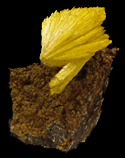|
|
| Formula: | Zn2(AsO4)(OH)•H2O |  Click to see a larger image |
||
| Crystal: | Monoclinic | |||
| Hardness: | 4.5 | |||
| Spec. Gr.: | 3.98 | |||
| Streak: | White | |||
| Cleavage: | Poor in 1 direction | |||
| Location: | Mapimi, Mexico |
| Nearly all of the beautiful golden-yellow legrandite crystals in the world came from the twelfth and seventeenth levels of the Ojuela mine at Mapimi, Durango, Mexico from 1962-1979. The famous Aztec Sun specimen measuring twenty centimeters in length was found on the seventeenth level in early 1979. The largest crystal ever discovered was found four weeks later and measured twenty-eight centimeters. The type locality (world's first discovery) is the Flor de Peña mine at Lampazos de Naranjo, Nuevo Leon, Mexico when four centimeter crystals of legrandite were discovered in the 1920's. Legrandite is found sparingly at Tsumeb, Namibia; and at the Sterling Hill Mine, Franklin, New Jersey. The mineral is a zinc hydrous arsenate, but has no commercial value. Associate minerals are adamite and hemimorphite. |
|
Bibliography: Panczner, William, Minerals of Mexico, Van Nostrand, Reinhold, NY, 1987. |
|
University of California, Santa Barbara—Department of Earth Science Copyright © 2005 Regents of the University of California Send your comments to the Web Page Editor |